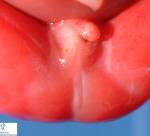anorectal malformations
Image Gallery
[ ( ||image_reduire{0,60}|inserer_attribut{alt,Anorectal atresia: imperforate anus and rectovesical fistula (22 (...)})
]
[
(
||image_reduire{0,60}|inserer_attribut{alt,Anorectal atresia: imperforate anus and rectovesical fistula (22 (...)})
]
[
( ||image_reduire{0,60}|inserer_attribut{alt,Anal imperforation})
]
[
(||image_reduire{0,60}|inserer_attribut{alt,Rectourethral fistula})
]
[
(||image_reduire{0,60}|inserer_attribut{alt,Association of anal imperforation with rectourethral fistula})
]
[
(
||image_reduire{0,60}|inserer_attribut{alt,Anal imperforation})
]
[
(||image_reduire{0,60}|inserer_attribut{alt,Rectourethral fistula})
]
[
(||image_reduire{0,60}|inserer_attribut{alt,Association of anal imperforation with rectourethral fistula})
]
[
( ||image_reduire{0,60}|inserer_attribut{alt,Association of anal imperforation with rectourethral fistula})
]
||image_reduire{0,60}|inserer_attribut{alt,Association of anal imperforation with rectourethral fistula})
]
Definition: Anorectal malformations comprise a wide spectrum of diseases, which can affect boys and girls, and involve the distal anus and rectum as well as the urinary and genital tracts. They occur in approximately 1 in 5000 live births.
Defects range from mild anal anomalies to complex cloacal malformations.
They can therefore be classified into the following groups: imperforated anus without fistula, ARM with rectourinary or rectogenital fistula and complex ARM (cloaca).
Classification
High anorectal malformations
![]() anorectal agenesis
anorectal agenesis
- without fistula
- with rectovaginal fistula
- with rectoprostatic fistula
- with rectourethral fistula
- with rectovesical fistula
![]() rectal atresia (high atresia)
rectal atresia (high atresia)
Intermediate anorectal malformations
![]() rectal atresia (intermediate)
rectal atresia (intermediate)
- with rectovestibular fistula
- with rectovaginal fistula
- with rectourethral fistula
Low anorectal malformations
![]() anal agenesis without fistula
anal agenesis without fistula
![]() anal agenesis with fistula
anal agenesis with fistula
- with anovestibular fistula
- with anocutaneous fistula
![]() anal stenosis
anal stenosis
![]() membranous atresia (covered anus)
membranous atresia (covered anus)
![]() anal agenesis
anal agenesis
Cloacal malformations
![]() persistent cloaca
persistent cloaca
Associations
Associated anomalies include genitourinary defects (in approximately 50% of patients) and spinal anomalies. A cloaca is associated with a urological problem (such as obstructive uropathy) in 90% of babies and with hydrocolpos in 50%.
Sacral anomalies (hemisacrum and sacral hemivertebrae) have been described; hemivertebrae may also affect the lumbar and thoracic spine, leading to scoliosis. A tethered spinal cord (in 25% of patients) may result in motor and sensory disturbances of the lower extremities. Syringomyelia and myelomeningocele can occur.
![]() uninary malformations or urinary anomalies (25-50%) (#12778281#)
uninary malformations or urinary anomalies (25-50%) (#12778281#)
- vesicoureteric reflux (25%)
- renal agenesis (8%)
- neurogenic bladder (6%)
- hydronephrosis with no vesicoureteric reflux
- renal hypoplasia
- ectopic kidney (2%)
- horseshoe kidney
![]() syndromic ARM
syndromic ARM
- Townes-Brocks syndrome
- Currarino syndrome
- Pallister-Hall syndrome
- trisomy 21 (Down syndrome)
Management
The radiological evaluation of a newborn with imperforate anus should include an abdominal and pelvic ultrasound to evaluate for genitourinary defects as they need to be dealt with in the newborn period to avoid serious complications.
Spinal ultrasound in the first three months of life and magnetic resonance imaging thereafter are useful radiological modalities for detecting spinal anomalies. The risk of ARM for a sibling of a patient with ARM can reach 1%.
Patients can either undergo a primary repair procedure (anoplasty) or a protective colostomy and definitive repair at a later date, depending on the malformation.
See also
![]() digestive malformations
digestive malformations
References
![]() Levitt MA, Pena A. Anorectal malformations. Orphanet J Rare Dis. 2007 Jul 26;2(1):33. PMID: #17651510#
Levitt MA, Pena A. Anorectal malformations. Orphanet J Rare Dis. 2007 Jul 26;2(1):33. PMID: #17651510#